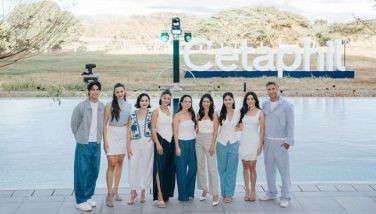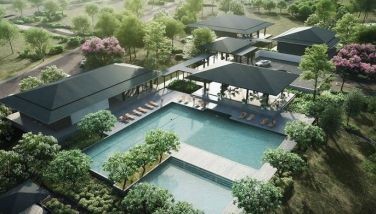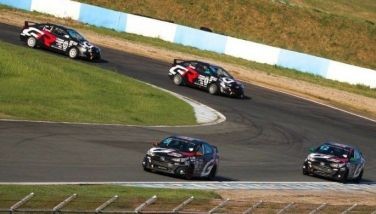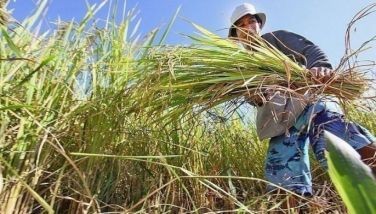Uriel’s journey home — a young pawikan’s story
May 8, 2005 | 12:00am
March 10, 2005. It was Thursday, and during its wee hours, nine-year-old "Uriel" was preparing to leave his childhood home behind in Barangay Manoc-Manoc, Boracay Island, Malay, Aklan. In just a few minutes, his parents will be entrusting him to new guardians, the Department of Environment and Natural Resources (DENR), so he could have more than what they can offer — a taste of what it is like to be in his natural home.
And, as any other real mother would feel, Manang Lenor Daquila-Gelito couldn’t help but get misty-eyed and emotional as she watched her ‘son’ go. She didn’t want to let him go just yet. She considers "Uriel", her eldest son’s namesake, to be not just a beloved pet, but a reincarnation of her own son who passed away several years ago. "Uriel" is an endangered hawksbill sea turtle, popularly known in the Philippines as pawikan. Her son was the first to take care of the pawikan, treating him as if he was his own.
"Uriel" first came to Manang Lenor’s life along with three other newly hatched turtles nine years ago when her cousin found them groping and crawling in the white sands of Boracay. Her cousin took care of the four tiny pawikans but later on decided to give them all to her for safekeeping.
To welcome the new members of their family, the Gelitos made a small pond in their backyard to serve as the turtles’ temporary shelter. The turtles were usually given fish, shrimps, squids and even bread loaves for food. It was not long when these tiny creatures, which have then became full-grown reptiles, became a source of attraction to children and adults alike, from neighboring places. Tourists even visit their house just to catch a glimpse of these endangered species.
Survival, however, became an issue among the pawikans due to their confinement in a very small pond, with very limited space. Aggression among the turtles became evident. One turtle died after the other, leaving "Uriel" with no siblings, but with more space all to himself. Although he did become more comfortable, the Gelitos could not avoid the inevitable question any longer – is keeping Uriel safe in their pond’s backyard enough to ensure its survival?
Although a difficult decision to make, Manang Lenor’s family felt that it was time to let their little boy go. That was when the family finally decided to turn him over to the DENR’s field office in Kalibo, Aklan. And their decision couldn’t have been more timely.
The DENR has been campaigning for all wildlife species in the possession of private individuals to be registered to avoid confiscation. The DENR couldn’t have been more willing to take care of young "Uriel" and provide him a new home.
DENR-Protected Areas and Wildlife Coordinator Nilo Subong facilitated everything from "Uriel’s" transport from the DENR’s office in Kalibo to his final destination in the Southeast Asian Fisheries Development Center (SEAFDEC) in Tigbauan, Iloilo. SEAFDEC was to be his home away for home for now.
At SEAFDEC, Uriel was met by Dr. Ellen Flor Doyola who showed him to a 10-tonner open tank where he will be taught how to live independently, hunt and search for his own food until he’s ready and the center could find a safer place for his release. There, he will be properly taken care of until he is fully acclimatized with the environment of his natural habitat. There he will wait in anticipation for the most momentous event in his life – his eventual release to the marine world!
Scientists call sea turtles as the only living remnants of the dinosaur age, but unless sincere efforts such as these are undertaken, it may not be for long that they might follow dinosaurs into extinction.
There are more than 220 species of turtles in the world, but only seven are considered marine (saltwater). Five of these species are present in the Philippines, namely: Green (Chelonia mydas), Hawksbill (Eretmochelys imbricata), Loggerhead (Caretta caretta), Olive Ridley (Lepidochelys olivacea) and Leatherback turtles (Dermochelys coriacea).
And, as any other real mother would feel, Manang Lenor Daquila-Gelito couldn’t help but get misty-eyed and emotional as she watched her ‘son’ go. She didn’t want to let him go just yet. She considers "Uriel", her eldest son’s namesake, to be not just a beloved pet, but a reincarnation of her own son who passed away several years ago. "Uriel" is an endangered hawksbill sea turtle, popularly known in the Philippines as pawikan. Her son was the first to take care of the pawikan, treating him as if he was his own.
"Uriel" first came to Manang Lenor’s life along with three other newly hatched turtles nine years ago when her cousin found them groping and crawling in the white sands of Boracay. Her cousin took care of the four tiny pawikans but later on decided to give them all to her for safekeeping.
To welcome the new members of their family, the Gelitos made a small pond in their backyard to serve as the turtles’ temporary shelter. The turtles were usually given fish, shrimps, squids and even bread loaves for food. It was not long when these tiny creatures, which have then became full-grown reptiles, became a source of attraction to children and adults alike, from neighboring places. Tourists even visit their house just to catch a glimpse of these endangered species.
Survival, however, became an issue among the pawikans due to their confinement in a very small pond, with very limited space. Aggression among the turtles became evident. One turtle died after the other, leaving "Uriel" with no siblings, but with more space all to himself. Although he did become more comfortable, the Gelitos could not avoid the inevitable question any longer – is keeping Uriel safe in their pond’s backyard enough to ensure its survival?
Although a difficult decision to make, Manang Lenor’s family felt that it was time to let their little boy go. That was when the family finally decided to turn him over to the DENR’s field office in Kalibo, Aklan. And their decision couldn’t have been more timely.
The DENR has been campaigning for all wildlife species in the possession of private individuals to be registered to avoid confiscation. The DENR couldn’t have been more willing to take care of young "Uriel" and provide him a new home.
DENR-Protected Areas and Wildlife Coordinator Nilo Subong facilitated everything from "Uriel’s" transport from the DENR’s office in Kalibo to his final destination in the Southeast Asian Fisheries Development Center (SEAFDEC) in Tigbauan, Iloilo. SEAFDEC was to be his home away for home for now.
At SEAFDEC, Uriel was met by Dr. Ellen Flor Doyola who showed him to a 10-tonner open tank where he will be taught how to live independently, hunt and search for his own food until he’s ready and the center could find a safer place for his release. There, he will be properly taken care of until he is fully acclimatized with the environment of his natural habitat. There he will wait in anticipation for the most momentous event in his life – his eventual release to the marine world!
Scientists call sea turtles as the only living remnants of the dinosaur age, but unless sincere efforts such as these are undertaken, it may not be for long that they might follow dinosaurs into extinction.
There are more than 220 species of turtles in the world, but only seven are considered marine (saltwater). Five of these species are present in the Philippines, namely: Green (Chelonia mydas), Hawksbill (Eretmochelys imbricata), Loggerhead (Caretta caretta), Olive Ridley (Lepidochelys olivacea) and Leatherback turtles (Dermochelys coriacea).
BrandSpace Articles
<
>
- Latest
Latest
Latest
November 9, 2024 - 3:43pm
By E.H. Edejer | November 9, 2024 - 3:43pm
June 9, 2024 - 5:55pm
By Alberto Peña | June 9, 2024 - 5:55pm
May 24, 2024 - 10:00am
May 24, 2024 - 10:00am
May 14, 2024 - 3:43pm
By Ian Laqui | May 14, 2024 - 3:43pm
April 10, 2024 - 5:12pm
By Ian Laqui | April 10, 2024 - 5:12pm
Recommended





























